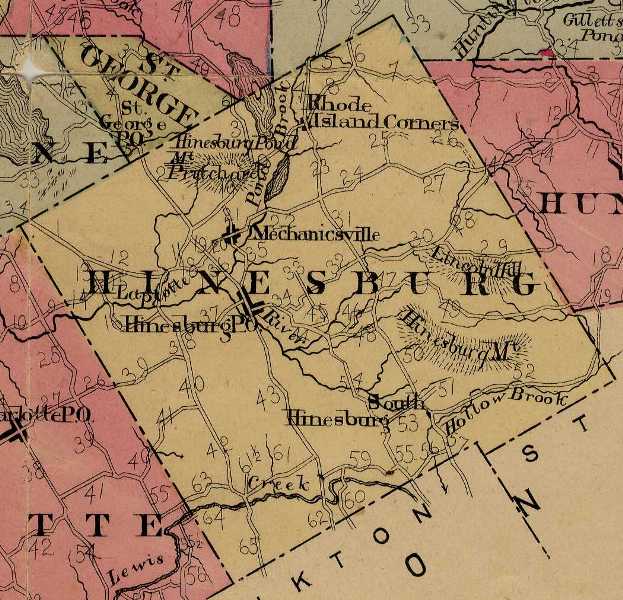History
Historic Maps
Interactive Map
Photos
Resources |
An Agricultural History of
Hinesburg, Vermont
Hinesburg,
Vermont was established on June 24, 1762 under a charter granted to
sixty-five individuals, 
including Abel Hine, the proprietor’s clerk, for whom the town is
named. The charter, granted by the Province of New Hampshire,
detailed a “new plantation” founded upon the development of farming:
“As soon as there shall be fifty families residing…every Grantee his
hers and assigns, shall plant and cultivate five acres of land within
the term of five years for every fifty acres contained in his or their
share…Yielding and paying therefore to us, the rent of one ear of
Indian corn only, on the 25th day of December.” [1]
The town is located in Chittenden County and bounded to the north by
the towns of Shelburne, St. George, Williston, and Richmond; to the
east by Huntington and Starksboro; to the south by Monkton and to the
west by Charlotte. The landscape combines rolling hills and
leveled pastures. The La Platte River enters the town from
the western border, discontinuing in  South
Hinesburg.
Running from La Platte, Patrick Brook feeds into Lower Pond and then
the Iroquois River at the north boundary (Figure 3). In 1868,
The Vermont Historical Gazetteer discusses the state of the land,
identifying the eastern section of town as maintaining arable soil,
which makes for profitable dairy farms.[2] Despite the affluent
soil in the east, at the time farms were scattered evenly throughout
the
town.[3]
After the
Civil War, 14 of the 17 towns in Chittenden County dropped in
population. At this time, only three  towns grew – Essex, Colchester, and
Burlington. By 1870, the town lost 7% of its population and
dropped another 15% in 1880.[6] The turn in population was
contributed by economical trouble. In 1887, an article in the
Burlington Free Press and Times discusses an alarming emigration of
Hinesburg residents emigrating westward due to a lack of employment:“Is
it for their interest to have our rural towns reduced to broad farms of
fairy grass fields and pastures, run by machinery?”[7]
At the same time, cheese factories, owned by stock companies, were
developing in town. The Valley Cheese Factory was the first factory of
its kind in the county, established in 1866. The factory
sought out management from New York.[8] A second company, The Union
Cheese Factory, was built in 1871. As of 1882, The Valley
Cheese Factory received milk from 300 cows, manufacturing 60,000 lbs.
of cheese annually.[9] The Union Cheese Factory manufactured
cheese from the milk of 250 cows.[10]
 United States Agricultural Census from 1850 to
1880 detailed milk, butter and cheese as three major products in
Hinesburg. The 1880 census queries altered slightly to
coordinate with the increasing factories developing in the
state. A new column was added to list the amount of milk
produced for the purpose of sending to factories for production of
cheese and butter. Similarly, the data for cheese produced
in-house decreased accordingly with the rise of factories. A
second alteration in the 1880 census is the separation of individuals
who conduct farm procedures into categories of owners, those who rent
for a fixed cost, and those who rent for shares of the
product. In 1880, 11% of the individuals rented for a fixed
cost and 31% rented for shares of the product. In 1850, the
number of farmers participating in the census numbered 124.
In 1860, the number rose to 163. In 1870, the number hit 182
and in 1880 farmers numbered at 200. The evolving dairy
industry that has sustained through the Hinesburg’s history has
dissipated in the past few years, with the prominence of maple sugar
processing. United States Agricultural Census from 1850 to
1880 detailed milk, butter and cheese as three major products in
Hinesburg. The 1880 census queries altered slightly to
coordinate with the increasing factories developing in the
state. A new column was added to list the amount of milk
produced for the purpose of sending to factories for production of
cheese and butter. Similarly, the data for cheese produced
in-house decreased accordingly with the rise of factories. A
second alteration in the 1880 census is the separation of individuals
who conduct farm procedures into categories of owners, those who rent
for a fixed cost, and those who rent for shares of the
product. In 1880, 11% of the individuals rented for a fixed
cost and 31% rented for shares of the product. In 1850, the
number of farmers participating in the census numbered 124.
In 1860, the number rose to 163. In 1870, the number hit 182
and in 1880 farmers numbered at 200. The evolving dairy
industry that has sustained through the Hinesburg’s history has
dissipated in the past few years, with the prominence of maple sugar
processing.
---------------------------------------------------------------
[1] New Hampshire (Colony) Probate Court, Charter Records: Hinesburgh,
Provincial and State Papers (1895),
224-227.
[2] Rev. C.E. Ferrin, Hinesburgh, The Vermont Historical Gazetteer
(Burlington: A.M. Hemenway, 1868),
792.
[3] Hamilton Child, Town of Hinesburgh, Gazetteer and Business
Directory of Chittenden County, for
1882-1883 (Syracuse: Hamilton Child,
1882-1883), 317-328.
[4] Erastus Bostwick, 1861 History and Tales of Hinesburgh, Vermont,
(Hinesburg: Erastus Bostwick 1861;
reprint, Hinesburg: Hinesburg
Bicentennial Committee, 1976), p.27.
[5] “Hinesburgh ‘Imperishable Potato’ Factory.” The (Burlington) Daily
Free Press. 11 June, 1853, p. 2
[6] Bostwick, 1861 History and Tales of Hinesburgh, Vermont, p. 27.
[7] “Hinesburgh,” Burlington Free Press and Times, 3 May 1877, p. 3.
[8] “Hinesburgh Cheese Factory.” The Daily Free Press. 11 June 1866,
pg. 4.
[9] Child, Gazetteer and Business Directory of Chittenden County, 206.
[10] Ibid, 204.
|

